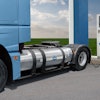
Recent years have shown how fickle our supply chains can be. With global crises such as the COVID-19 pandemic and geopolitical challenges such as the current tariff uncertainties, supply chain disruptions lead to price increases, widespread shortages, and other severe consequences.
While there has been some relief in these situations — such as “pauses” in the tariffs — these reprieves are often not long enough for businesses to build up an adequate surplus. Many tariff pauses are for a period of 30 or 60 days, but processing and fulfilling international orders can take as long as 12 weeks. Because of this, it is crucial to establish a resilient supply chain that can withstand these changing conditions, which involves taking steps such as diversification and building a reserve during times of prosperity.
That being said, there is one factor that many people often overlook when it comes to supply chain resiliency: energy.
Why energy is an important factor in supply chain resiliency
Energy and supply chain management are closely intertwined. Using the current tariffs situation as an example, tariffs on fuel and coal cause energy prices to increase. These increases, in turn, cause manufacturers to incur additional costs, which are then passed on to consumers. Or, if another supply chain crisis occurs, such as a disruption in shipping routes, factories may not receive the necessary energy to continue production at their current levels, forcing them to scale back or even pause their production entirely.
Considering the volatile nature of fuel prices, tariffs, and international trade in general, it may seem to some manufacturers that it would be impossible to prepare for these obstacles and market changes. However, there is a solution that would enable businesses to plan more effectively for these potential disruptions: commercial energy storage. Functioning as a battery back-up, commercial energy storage helps to build an energy ecosystem that enables businesses to manage their energy consumption, ensuring continuity and reducing bills.
How energy storage helps manufacturers build a more resilient supply chain
Energy storage is a crucial step in the decentralization of energy consumption, a process that will lead to significantly improved energy efficiency. When businesses install commercial energy storage systems alongside alternative energy generation such as solar (PV), they gain energy autonomy, enabling them to generate, store, and utilize their own energy, thereby reducing their reliance on centralized utilities that are often powered by fossil fuels. Additionally, commercial energy storage helps minimize transmission losses, as energy stored locally means power no longer needs to be transmitted over long distances.
Because businesses that use commercial energy storage are less dependent on the grid, they also become less susceptible to grid variability. Peaks and troughs in energy availability and cost become much less pronounced as intelligent systems optimize when a business relies more on grid power and when it relies on stored power. This also allows businesses to reduce their strain on the grid, reducing the chance of disruptions on a broader scale.
Some ways in which these benefits manifest themselves include:
- Operational continuity: When you use commercial energy storage, these devices can act as a backup power source, allowing you to draw on stored energy in the event of grid outages or power quality issues. This functionality can be key in minimizing downtime and service disruptions.
- On-site renewable energy use: Commercial energy storage is a fundamental element for a business to fully utilize on-site renewable energy. Energy sources such as solar and wind rely heavily on weather conditions, so commercial storage ensures that you have a sufficient reserve for when production levels drop.
- Peak shaving: Commercial energy storage can help manufacturers save on their energy costs through a process known as peak shaving. During high-demand periods, when energy costs are higher, manufacturers can draw from storage rather than the grid, helping to stabilize their energy expenses.
- Better planning and energy forecasting: Due to these factors, commercial energy storage can enable manufacturers to plan and forecast their energy consumption more effectively. They will have better insight into their usage trends and be able to adjust their consumption to account for expected changes in availability or cost of grid energy.
Achieving energy resiliency is essential for manufacturers, as it ensures that operations can continue consistently, reliably, and smoothly — even in the case of power outages or increases in energy pricing. In doing so, supply chains risks are lowered, and these issues are prevented from escalating into full-blown supply chain crises, as those we have seen in recent years.
Energy is one factor manufacturers cannot afford to ignore when looking to establish resiliency and continuity in their supply chains. By investing in commercial energy storage, manufacturers can ensure that their supply chains are not disrupted by events such as power outages or increases in energy prices, thereby maintaining consistency amid uncertainty. Manufacturers looking to reap these benefits should invest in a commercial energy storage system today.

















